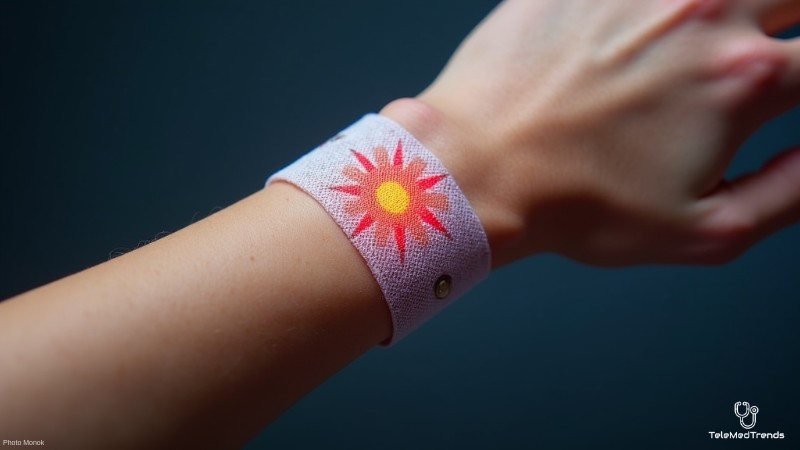The field of wearable health technology is constantly evolving, yet one major challenge has remained—accurately distinguishing multiple biological signals when they occur simultaneously. This limitation has slowed progress in real-time health monitoring, preventing more precise and effective patient care. However, a groundbreaking discovery by researchers from Penn State and China’s Hebei University of Technology may finally overcome this obstacle.
The research team has developed an advanced flexible sensor capable of independently measuring both temperature and physical strain. This innovation could significantly enhance medical applications, particularly in wound healing and post-surgical recovery.
Their findings, published in Nature Communications, highlight a newly discovered property in laser-induced graphene (LIG), allowing for more accurate tracking of the body’s healing process.
With this cutting-edge technology, healthcare professionals may soon be able to monitor recovery with unprecedented precision, detecting complications at an earlier stage and intervening more effectively.
By providing real-time insights into a patient’s condition, this sensor could lead to faster treatments, reduced hospital stays, and improved overall outcomes. As wearable health devices continue to advance, this discovery represents a major step forward in personalized and responsive medical care.
Key Takeaways
Researchers at Penn State and Hebei University of Technology have developed an innovative flexible sensor using laser-induced graphene (LIG) that can independently measure temperature and physical strain, set to transform wound care and post-operative recovery in the United States.
- A new sensor material overcomes the problem of signal interference in medical monitoring by accurately measuring both temperature and physical strain.
- The sensor’s thermoelectric features allow it to generate electrical voltage from temperature variations, enabling precise tracking of a patient’s condition.
- This technology can be integrated into current medical devices such as smart bandages, boosting their performance without major infrastructure changes.
A Game-Changing Approach to Health Monitoring
Dr. Huanyu “Larry” Cheng, a leading researcher on the project, explains that their new sensor material solves a fundamental problem in medical monitoring: the interference between temperature fluctuations and physical strain.
Traditionally, sensors have struggled to distinguish between these factors, often leading to inaccurate readings. But the unique properties of LIG have allowed the researchers to create a sensor capable of decoupling these measurements, providing clear and precise data.
LIG, a two-dimensional (2D) material, is produced through a process that converts carbon-rich substances like plastic or wood into graphene structures using a laser. Unlike conventional graphene, which requires complex fabrication techniques, LIG can be directly “written” onto surfaces, making it an easily scalable option for various applications, including health care.
The key breakthrough came when Cheng’s team unexpectedly discovered that LIG exhibits thermoelectric properties—meaning it can generate electrical voltage in response to temperature changes. This property allows their sensor to track temperature shifts and physical strain independently, ensuring a more accurate assessment of wound healing.
In practical terms, this means that if a wound becomes inflamed, the sensor can detect temperature changes without mistaking them for mechanical strain caused by movement. Likewise, if a patient moves, the sensor will not misinterpret the physical strain as a change in temperature.
This level of precision is crucial for medical professionals monitoring post-surgical recovery or chronic wound healing, as early intervention can prevent complications and speed up the healing process.
Beyond measuring temperature and strain, LIG’s sensitivity makes it useful for detecting tiny changes in biological conditions that could indicate infection or delayed healing. By continuously tracking a wound’s condition, doctors can adjust treatment strategies in real-time, ensuring optimal recovery.
The flexibility and adaptability of this material also mean it can be seamlessly incorporated into existing medical devices, such as smart bandages or wearable monitors, enhancing their functionality without requiring drastic changes in medical infrastructure.
The Future of Wearable Health Technology
A groundbreaking new sensor harnesses LIG’s thermoelectric effect to generate power from body heat, eliminating the need for batteries or external charging. This self-sustaining design enables continuous health monitoring without disrupting daily life.
Highly flexible and stretchable, the sensor conforms to various surfaces and moves naturally with the body. Unlike rigid thermoelectric materials, its porous LIG structure enhances sensitivity while maintaining durability. This makes it ideal for integration into bandages, smart clothing, and wearable medical devices.
Beyond healthcare, its applications extend to fire detection, industrial safety, and environmental monitoring. With the ability to track temperature changes and mechanical stress accurately, the sensor could improve real-time risk assessment.
Researchers are also exploring wireless integration for remote monitoring via smartphones, allowing doctors to track patients’ recovery and alert responders to emergencies.
The potential for personalized medicine is immense. As telehealth expands, real-time data from LIG-based sensors can provide instant updates on a patient’s condition, enabling timely interventions. For those with chronic wounds, diabetes-related ulcers, or post-surgical recovery needs, this technology could reduce hospital visits and improve condition management.
Affordability is another key advantage. Produced from common materials like plastics and wood, LIG-based sensors cost significantly less than traditional medical devices. This makes them accessible even in resource-limited healthcare settings, broadening access to quality care worldwide.
Looking ahead, Cheng and his team are refining the sensor’s capabilities with support from the National Institutes of Health and the U.S. National Science Foundation. Their goal is to expand its use across multiple industries, integrating it into cloud-based monitoring systems for large-scale deployment in hospitals, clinics, and homes.
The introduction of this flexible, self-powered sensor represents a major leap in precision health monitoring. By addressing long-standing challenges in wearable technology, researchers are paving the way for smarter, more effective medical interventions.
As advancements in nanotechnology and artificial intelligence continue, innovations like this will play a crucial role in modern medicine—enhancing care, preventing complications, and ultimately saving lives.






